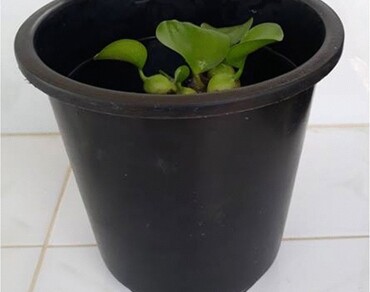Soluble phenolics, chlorophylls, and malondialdehyde are the best indicators of salt stress in Eichornia crassipes
Hernández-Fernández Leslie, Vázquez José Gerardo, Hernández Lázaro, Pérez-Bonachea Lisbet, Campbell Roberto, Martínez Julia, Hajari Elliosha, Zayas Roberto González-De, Acosta Yanier, Lorenzo José Carlos
Short Communications | Published: 30 June, 2023
First Page: 1195
Last Page: 1201
Views: 3028
Keywords: Aquatic plants, Climate change, Invasive plants, Salt stress, Water salinization
Abstract
This work describes the biochemical responses of water hyacinth (Eichhornia crassipes) plants to salinity stress under controlled conditions. Low to medium levels of necrosis were observed with plant fresh weight remaining stable across all treatments. Investigation of lipid peroxidation products revealed that levels of malondialdehyde were significantly increased in leaves and stems when plants were exposed to 40 mM NaCl indicative of membrane damage. Measurement of soluble and cell wall-linked phenolics indicated a decrease in levels in response to the stress. Increased concentrations of NaCl also resulted in decreased levels of chlorophyll a and b in leaves and stems, particularly when 40–80 mM NaCl was present. The carotenoid content of leaves and stems was reduced following exposure to NaCl but was more stable in roots. The results indicate that water hyacinth plants are sensitive to salinity stress with toxicity symptoms typified by leaf necrosis. This was apparent in the increased incidence of stress markers (malondialdehyde) and reduced chlorophyll levels. The inability of plants to mobilize an appropriate defense (indicated by reduced phenolic levels) provided further evidence for their biochemical and physiological sensitivity.
Key message
Sodium chloride modifies levels of aldehydes, phenolics, chlorophylls and carotenoids in water hyacinth.

References
Akhter MS, Noreen S, Mahmood S, Ashraf M, Alsahli AA, Ahmad P (2021) Influence of salinity stress on PSII in barley (Hordeum vulgare L.) genotypes, probed by chlorophyll-a fluorescence. J King Saud Univ-Sci 33:101239
Arámburo-Miranda IV, Ruelas-Ramírez EH (2017) Desalination of sea water with aquatic lily (Eichhornia crassipes). Environ Sci Poll Res 24:25676–25681
Assimakopoulou A, Salmas I, Nifakos K, Kalogeropoulos P (2015) Effect of salt stress on three green bean. Not Bot Hort Agr Cluj-Napoca 43:113
Bick E, de Lange ES, Kron CR, da Silva SL, Liu J, Nguyen HD (2020) Effects of salinity and nutrients on water hyacinth and its biological control agent, Neochetina bruchi. Hydrobiologia 847:3213–3224
Cipriano R, Martins JPR, Rodrigues LCdA, Falqueto AR, Gontijo ABPL (2021) Impact of saline solution on growth and photosystem II during in vitro cultivation of Bromelia antiacantha (Bromeliaceae). Rodriguésia. https://doi.org/10.1590/2175-7860202172018
Forno IW, Wright AD (1981) The biology of Australian weeds. 5. Eichhornia crassipes (Mart.) Solms. J Aust Lnst Agric Sci 47:21–28
Gallardo B, Capdevila L (2018) Cambio climático y especies exóticas invasoras en la red de parques nacionales: diagnóstico, adaptación y gobernanza. Proyecto BioCambio, Fundación Biodiversidad. https://doi.org/10.13140/RG.2.2.12300.36489
Gurr S, McPherson J, Bowles D (1992) Lignin and associated phenolic acids in cell walls. In: Wilkinson DL (ed) Molecular Plant Pathology. Oxford Press, Oxford, pp 51–56
Heath R, Packer J (1968) Photoperoxidation in isolated chloroplast: I. Kinetics and stoichiometry of fatty acid peroxidation. Arch Biochem Biophys 125:189–198
Hu Q, Ding F, Li M, Zhang X, Zhang S, Huang B (2021) Strigolactone and ethylene inhibitor suppressing dark-induced leaf senescence in perennial ryegrass involving transcriptional downregulation of chlorophyll degradation. J Am Soc Horticult Sci 1:1–8
Hussain MI, Reigosa MJ (2021) Secondary metabolites, ferulic acid and p-hydroxybenzoic acid Induced toxic effects on photosynthetic process in Rumex acetosa L. Biomolecules 11:233
Iturralde-Vinent M, Méndez HS (2015) Peligros y vulnerabilidades de la zona marino-costera de Cuba: Estado actual y perspectivas ante el cambio climático hasta el 2100 Editorial Academia.
Kamusoko R, Jingura RM (2022) Phytoremediation potential of non-edible biofuel plants: Physic nut (Jatropha curcas), castor bean (Ricinus communis) and water hyacinth (Eichhornia crassipes). Bioen Crops. CRC Press, pp 71–93
Lage-Pinto F, Oliveira JG, Da Cunha M, Souza CM, Rezende CE, Azevedo RA, Vitória AP (2008) Chlorophyll a fluorescence and ultrastructural changes in chloroplast of water hyacinth as indicators of environmental stress. Environ Exp Bot 64:307–313
Lazár D (1999) Chlorophyll a fluorescence induction. Biochem Biophys Acta 1412:1–28
Lichtenthaler HK (1987) Chlorophylls and carotenoids: pigments of photosynthetic biomembranes. Meth Enzymol 148:350–382
Lorenzo JC, Yabor L, Medina N, Quintana N, Wells V (2015) Coefficient of variation can identify the most important effects of experimental treatments. Not Bot Horti Agrobo Cluj-Nap 43:287–291
Lowe S, Browne M, Boudjelas S, De Poorter M (2004) 100 de las especies exóticas invasoras más dañinas del mundo. Una selección del Global Invasive Species Database Unión Mundial para la Naturaleza (UICN).
Moreira M, They N, Rodrigues L, Alvarenga-Lucius L, Pita-Barbosa A (2023) Salty freshwater macrophytes: the effects of salinization in freshwaters upon non-halophyte aquatic plants. Sci Total Environ 857:159608
Munns R (1993) Physiological processes limiting plant growth in saline soils: some dogmas and hypotheses. Plant Cell Environ 16:15–24
Munns R, Tester M (2008) Mechanisms of salinity tolerance. Ann Rev Plant Biol 59:651–681
Olivares E, Colonnello G (2000) Salinity gradient in the Mánamo River, a dammed distributary of the Orinoco Delta, and its influence on the presence of Eichhornia crassipes and Paspalum repens. Interciencia 25:242–248
Patnaik P, Abbasi T, Abbasi S (2022) Salvinia (Salvinia molesta) and water hyacinth (Eichhornia crassipes): two pernicious aquatic weeds with high potential in phytoremediation. In: Advances in sustainable development. Proceedings of HSFEA 2020, pp 243–260
Porra R (2002) The chequered history of the development and use of simultaneous equations for the accurate determination of chlorophylls a and b. Photosynth Res 73:149–156
Sharma AK, Sharma V, Sharma V, Sharma JK, Singh R (2020) Multifaceted potential of Eichhornia crassipes (water hyacinth) ladened with numerous value aided and therapeutic properties. Plant Arch 20:2059–2065
Vicino P, Carrillo J, Gómez R, Shahinnia F, Tula S, Melzer M, Rutten T, Carrillo N, Hajirezaei M-R, Lodeyro AF (2021) Expression of flavodiiron proteins Flv2-Flv4 in chloroplasts of Arabidopsis and tobacco plants provides multiple stress tolerance. Int J Mol Sci 22:1178
Author Information
Laboratory for Plant Breeding and Conservation of Genetic Resources, Bioplant Center, University of Ciego de Avila, Ciego de Ávila, Cuba